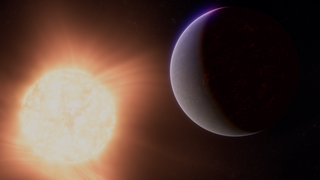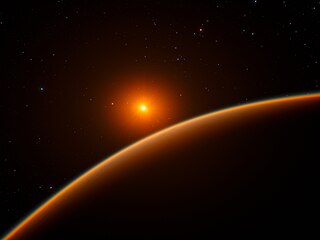
HD 219134 is a main-sequence star in the constellation of Cassiopeia. It is smaller and less luminous than the Sun, with a spectral class of K3V, which makes it an orange-hued star. HD 219134 is relatively close to our system, with an estimated distance of 21.34 light years. This star is close to the limit of apparent magnitude that can still be seen by the unaided eye. The limit is considered to be magnitude 6 for most observers. This star has a magnitude 9.4 optical companion at an angular separation of 106.6 arcseconds.

55 Cancri e is an exoplanet orbiting a Sun-like host star, 55 Cancri A. The mass of the exoplanet is about eight Earth masses and its diameter is about twice that of the Earth. 55 Cancri e was discovered on 30 August 2004, thus making it the first super-Earth discovered around a main sequence star, predating Gliese 876 d by a year. It is the innermost planet in its planetary system, taking less than 18 hours to complete an orbit. However, until the 2010 observations and recalculations, this planet had been thought to take about 2.8 days to orbit the star.
HD 97658 is a star with an exoplanetary companion in the equatorial constellation of Leo. The star is too dim to be seen with the naked eye, having an apparent visual magnitude of 7.76. It is located at a distance of 70 light years based on parallax, but is slowly drifting closer with a radial velocity of −1.6 km/s.

GJ 1132 b is an exoplanet orbiting GJ 1132, a red dwarf star 41 light-years from Earth, in the constellation Vela. The planet is considered uninhabitable but was thought to be cool enough to possess an atmosphere. GJ 1132 b was discovered by the MEarth-South array in Chile.

LHS 1140 is a red dwarf in the constellation of Cetus. Based on stellar parallax measurement, it is 48.8 light-years away from the Sun. 'LHS' refers to the Luyten Half-Second Catalogue of stars with proper motions exceeding half a second of arc annually. The star is over 5 billion years old and has only about 18% the mass of the Sun and 21% of its radius. LHS 1140's rotational period is 130 days. No flares have been observed.

LHS 1140 b is an exoplanet orbiting within the conservative habitable zone of the red dwarf LHS 1140. Discovered in 2017 by the MEarth Project, LHS 1140 b is about 5.6 times the mass of Earth and about 70% larger in radius, putting it within the super-Earth category of planets. It was initially thought to be a dense rocky planet, but refined measurements of its mass and radius have found a lower density, indicating that it is likely an ocean world with 9-19% of its mass composed of water. LHS 1140 b orbits entirely within the star's habitable zone and gets 43% the incident flux of Earth. The planet is 49 light-years away and transits its star, making it an excellent candidate for atmospheric studies with ground-based and/or space telescopes.
GJ 9827 is a star in the constellation of Pisces. It is a K-type main-sequence star with an apparent magnitude of 10.250. It is 97 light-years away, based on parallax.
HD 3167 is a single, orange-hued star in the zodiac constellation of Pisces that hosts a system with three exoplanets. The star is too faint to be seen with the naked eye, having an apparent visual magnitude of 8.97. The distance to HD 3167 can be determined from its annual parallax shift of 21.1363 mas as measured by the Gaia space observatory, yielding a range of 154 light years. It has a relatively high proper motion, traversing the celestial sphere at the rate of 0.204″ per year. Since it was first photographed during the Palomar observatory sky survey in 1953, it had moved over 12.5″ by 2017. The star is moving away from the Earth with an average heliocentric radial velocity of +19.5 km/s.

LTT 1445 is a triple M-dwarf system 22.4 light-years distant in the constellation Eridanus. The primary LTT 1445 A hosts two exoplanets—one discovered in 2019 that transits the star every 5.36 days, and another found in 2021 that transits the star every 3.12 days, close to a 12:7 resonance. As of October 2022 it is the second closest transiting exoplanet system discovered, with the closest being HD 219134 bc.

Kepler-1544b is a potentially habitable exoplanet announced in 2016 and located 1138 light years away, in the constellation of Cygnus.

Gliese 486, also known as Wolf 437 and formally named Gar, is a red dwarf star 26.4 light-years away in the constellation Virgo. It hosts one known exoplanet.
L 98-59 is a bright M dwarf star, located in the constellation of Volans, at a distance of 10.608 parsecs, as measured by the Gaia spacecraft.
HD 106315, or K2-109, is a single star with a pair of close-orbiting exoplanets, located in the constellation of Virgo. Based on parallax measurements, this system lies at a distance of 356 light years from the Sun. At that range, the star is too faint to be seen with the naked eye, as it has an apparent visual magnitude of 8.95. But it is slowly drifting closer with a radial velocity of −3 km/s. As of 2020, multiplicity surveys have not detected any stellar companions to HD 106315.












